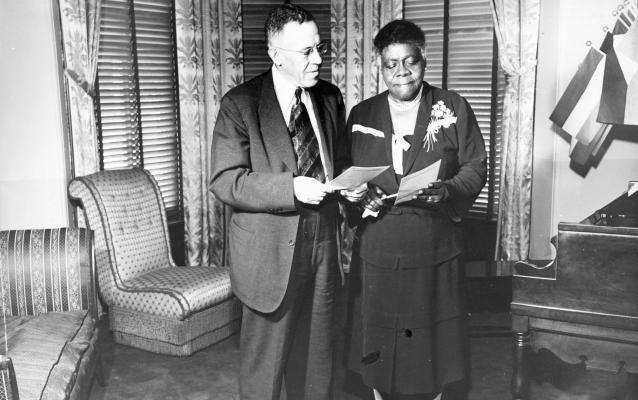Last updated: August 9, 2017
Lesson Plan
“It’s Up, and It’s Good!”
Negro League Baseball and its Connection to Mrs. Mary McLeod Bethune

- Grade Level:
- Upper Elementary: Third Grade through Fifth Grade
- Subject:
- Social Studies
- Lesson Duration:
- 90 Minutes
- State Standards:
- http://www.doe.virginia.gov/
- Additional Standards:
- L.6.7.
RIT.6.7.
SL.6.1d
SL.6.6
W.6.2a
http://www.socialstudies.org/standards/strands - Thinking Skills:
- Remembering: Recalling or recognizing information ideas, and principles. Understanding: Understand the main idea of material heard, viewed, or read. Interpret or summarize the ideas in own words. Applying: Apply an abstract idea in a concrete situation to solve a problem or relate it to a prior experience. Analyzing: Break down a concept or idea into parts and show the relationships among the parts. Creating: Bring together parts (elements, compounds) of knowledge to form a whole and build relationships for NEW situations. Evaluating: Make informed judgements about the value of ideas or materials. Use standards and criteria to support opinions and views.
Objective
This lesson will explore the powerful relationship between the National Council of Negro Women and Negro League Baseball. Students will discuss the important contributions, struggles and triumphs players experienced. Students will also understand the meaning of patriotism, and observe documented oral histories while using multi-media devices (Photo Story, PowerPoint, VoiceThread etc.) to demonstrate learning.
Background
One might ask, what connection does Homestead, PA have with Washington, DC? Perhaps one obvious answer would be the Homestead Grays baseball team. The original members of the Homestead Grays were steel workers from the Homestead/Pittsburgh area. During World War II, the Homestead Grays decided to expand to new horizons and gain new fans by playing some games in Washington, DC. At the time, Washington, DC had a growing Black population that considered baseball a great family pastime. It was also a good way to inspire interracial interaction between communities. Families would often get dressed up and spend an afternoon watching luminaries like Satchel Paige, James “Cool Papa” Bell, and Josh Gibson, who were phenomenal baseball players.
The Homestead Grays collaborated with Mrs. Bethune’s National Council of Negro Women (NCNW). Every year, right around the time of Mrs. Bethune’s birthday on July 10, the NCNW would sponsor baseball games to help in the fund-raising efforts for the Liberty ship S. S. Harriet Tubman. Harriet Tubman was an African American freedom fighter and hero who was active with the Underground Railroad for escaping slaves before the Civil War. This would be the first Liberty ship to be named after a woman. The goal was to raise 2 million dollars, and a portion of the baseball tickets would go to fund this cause. Eventually, the NCNW met their goal and successfully had the S. S. Harriet Tubman built to support overseas missions in World War II.
Preparation
Warm Up Activity
Through the direction of the teacher, students will do light exercise to stimulate the brain for analytical thinking. Some suggested exercises are as follows:
• Running in place
• Jumping Jacks
• Windmill stretch
Lesson Hook/Preview
Oral History Interviews
Mamie “Peanut” Johnson – female player for the Clowns Baseball Team
Homestead Grays: Gone But Not Forgotten (YouTube video with advertisement at start).
Procedure
1. Students will identify with the elements of “patriotism and purpose” by analyzing why communities were motivated to see players in the Negro Leagues.
2. Students will learn how economics has historically impacted communities.
3. Students will create digital stories from their perspective retelling the history of The Homestead Grays and their relationship with Mrs. Bethune. (Suggested technology: Photo Story or Voice Thread.)
4. Students may research through comparing and contrasting how Negro League Baseball players were treated in various parts of the United States but also celebrated by many races at their baseball games. http://www.nlbm.com/.
5. Students will work in collaborative groups to present their research findings.
Vocabulary
Segregation
Patriotism
Oral History
Economics
Community
Additional Resources
Lesson Extension
Moses Fleetwood Walker and John W. Bud Fowler were amongst the first players in professional baseball, playing in the 1870s and 1880s. Jackie Robinson joined the Brooklyn Dodgers in 1947. By the early 1960s, most of the Negro League baseball teams had dissolved. What is Jackie Robinson’s connection to Moses Fleetwood and John W. Bud Fowler? You may find your answer at the Negro League Baseball Museum. http://www.nlbm.com.
Related Lessons or Education Materials
Additional Helpful Links
The INSPIRATION software is a useful tool to help you begin the writing process:
http://www.inspiration.com/freetrial/index.cfm
Teacher’s Kit from the Negro League Baseball Museum:
http://www.coe.ksu.edu/annex/nlbemuseum/resource/toolkit.html
Information on various Negro League Baseball Players:
http://www.nlbpa.com/
Additional information for teachers to use regarding the Negro Leagues:
http://www.ala.org/programming/pridepassion/ppssn32
Additional Research Practice In African American Culture
1. Bethune Cookman University
www.cookman.edu
2. Schomburg Center for Research in Black Culture
www.nypl.org/locations/schomburg
3. Schlesinger Library
www.radcliffe.harvard.edu/schlesinger-library
4. Amistad Research Center
www.amistadresearchcenter.org
5. Moorland-Spingarn Research Center at Howard University
www.howard.edu/msrc/
